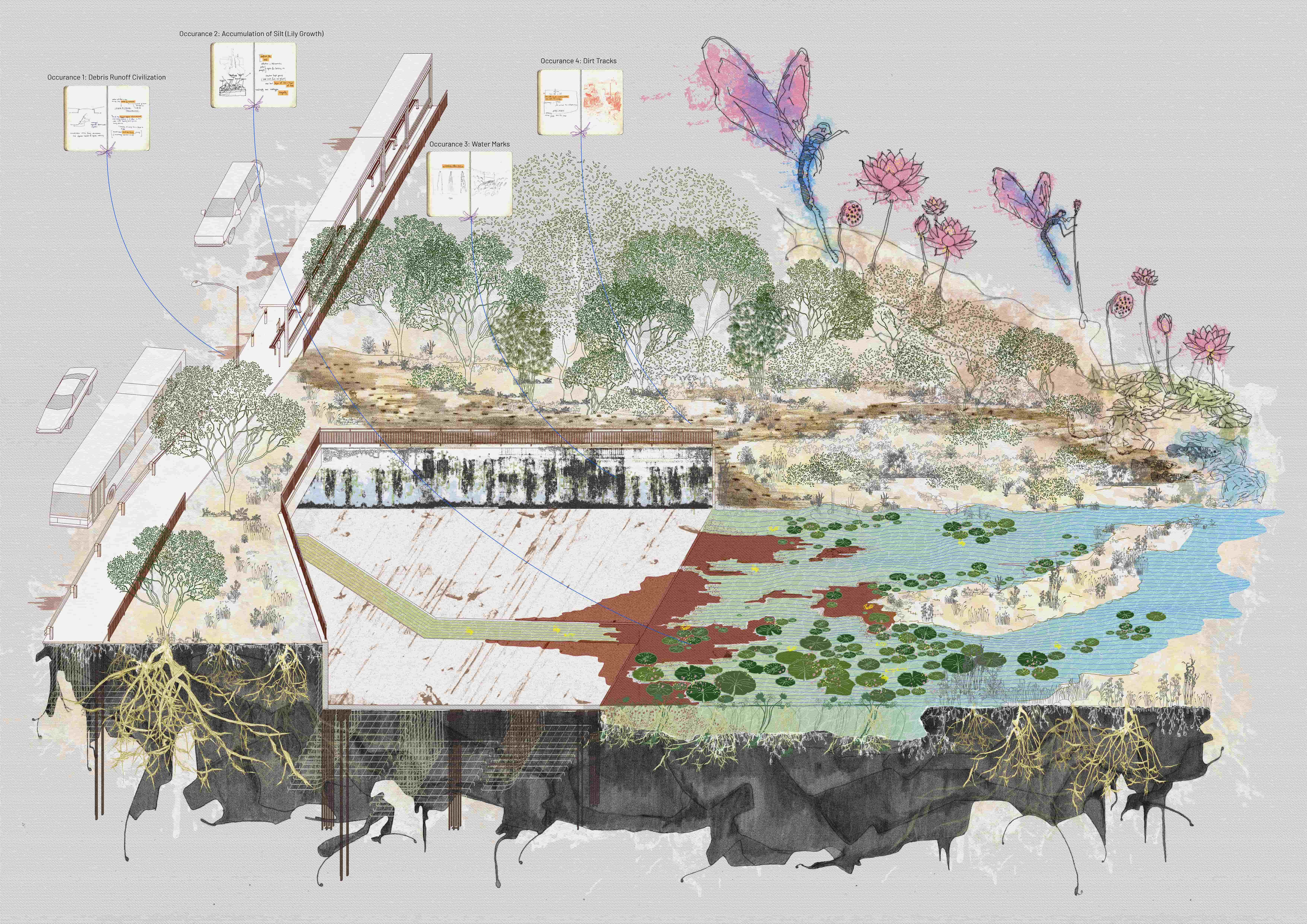
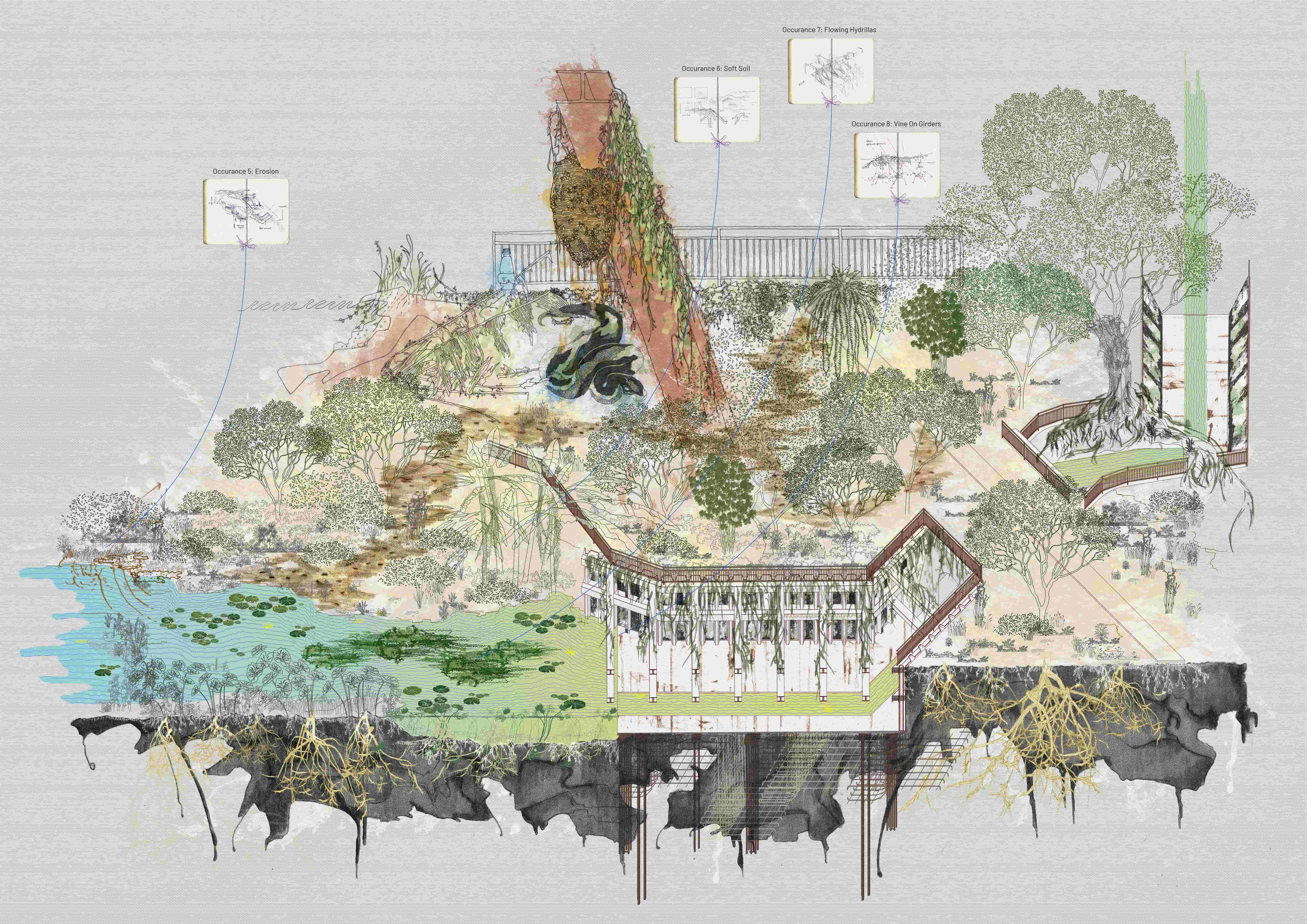
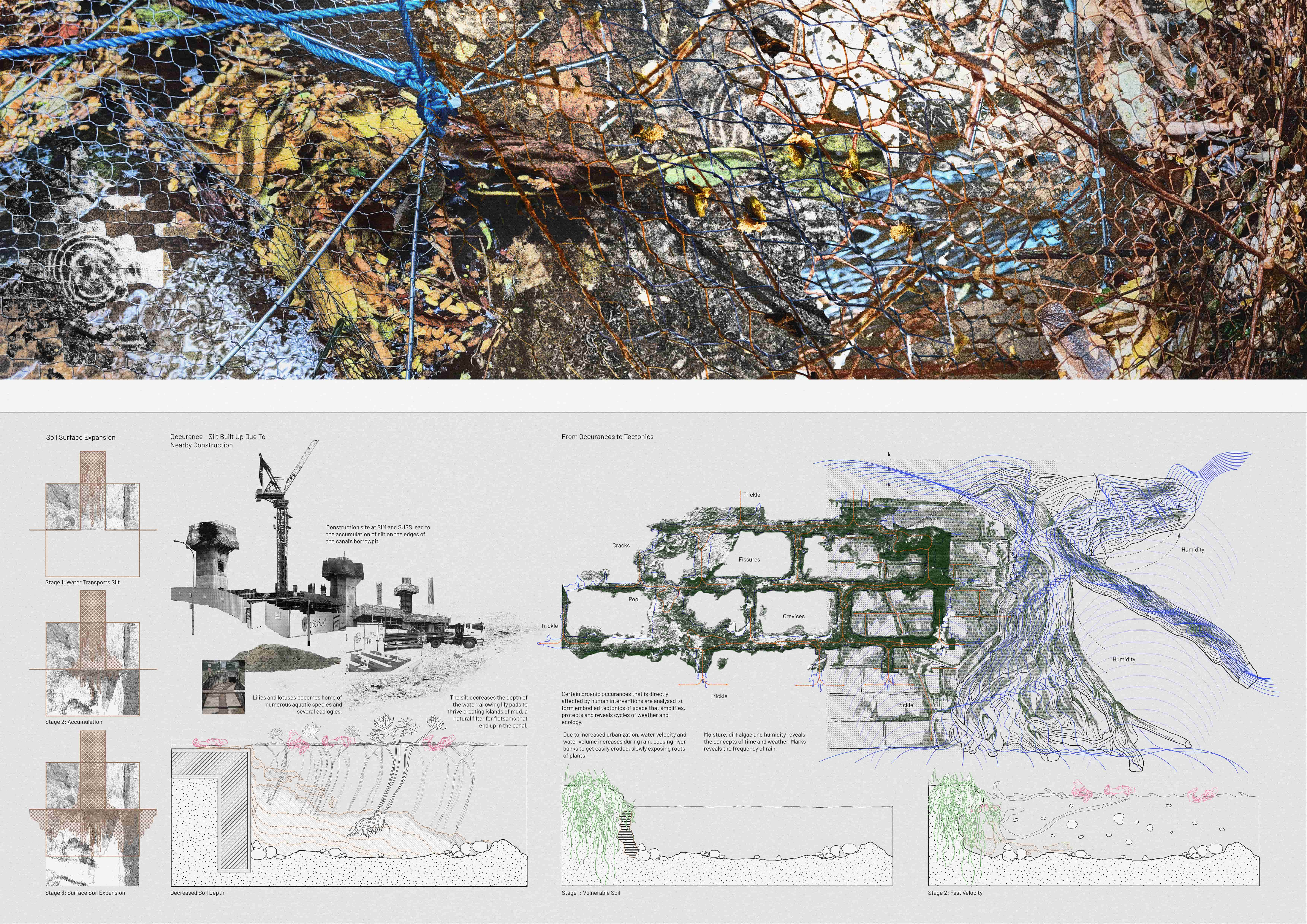

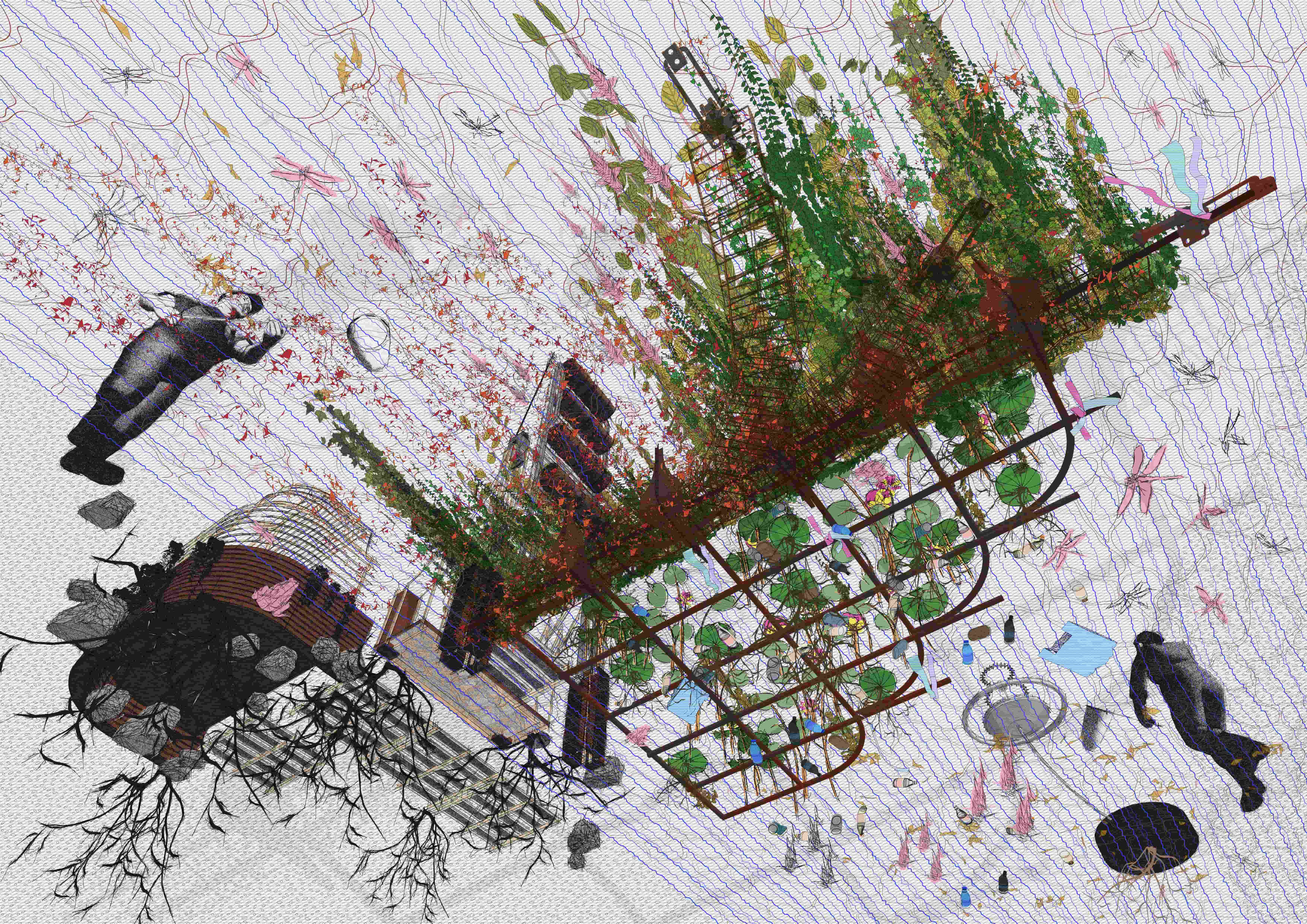

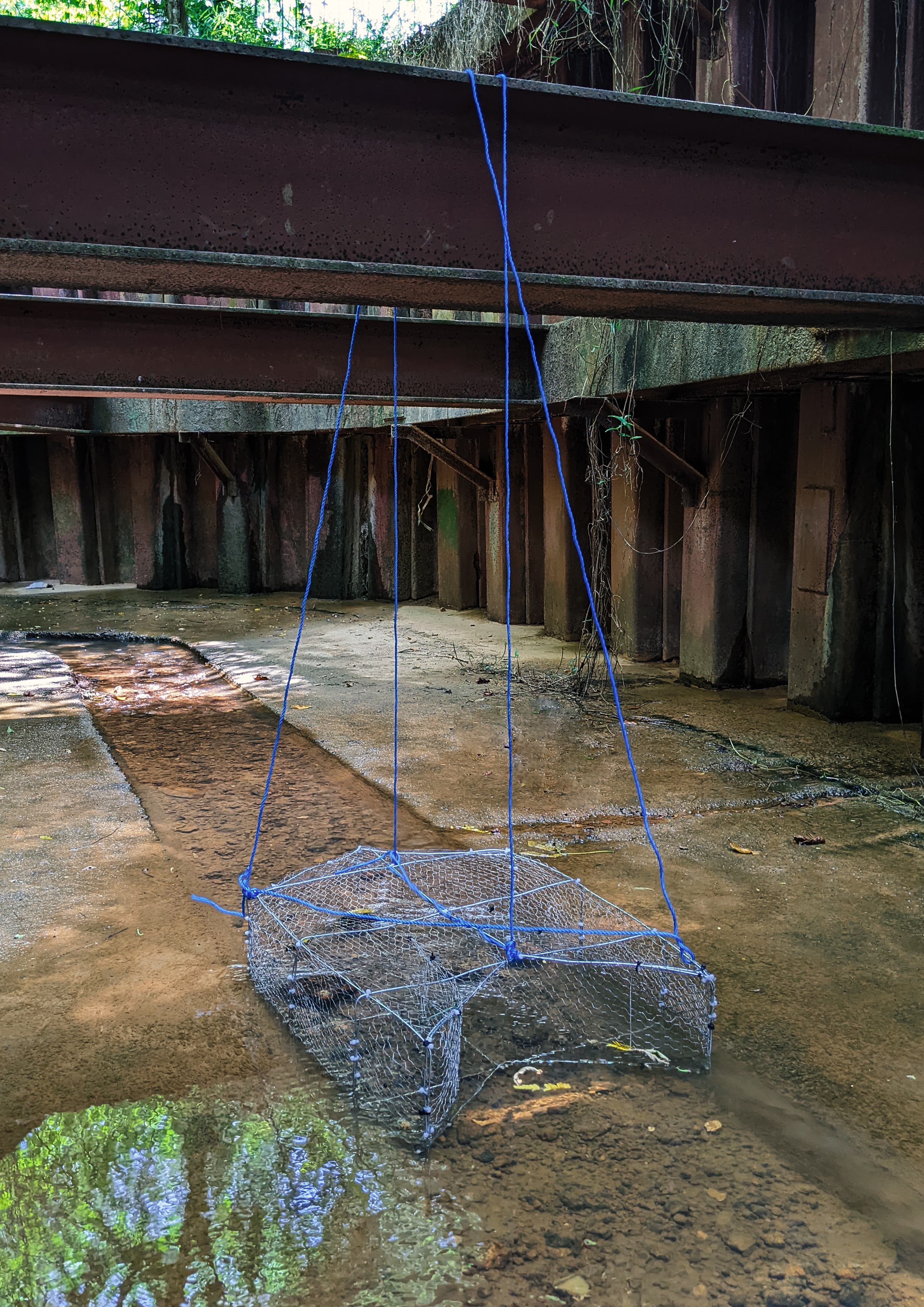
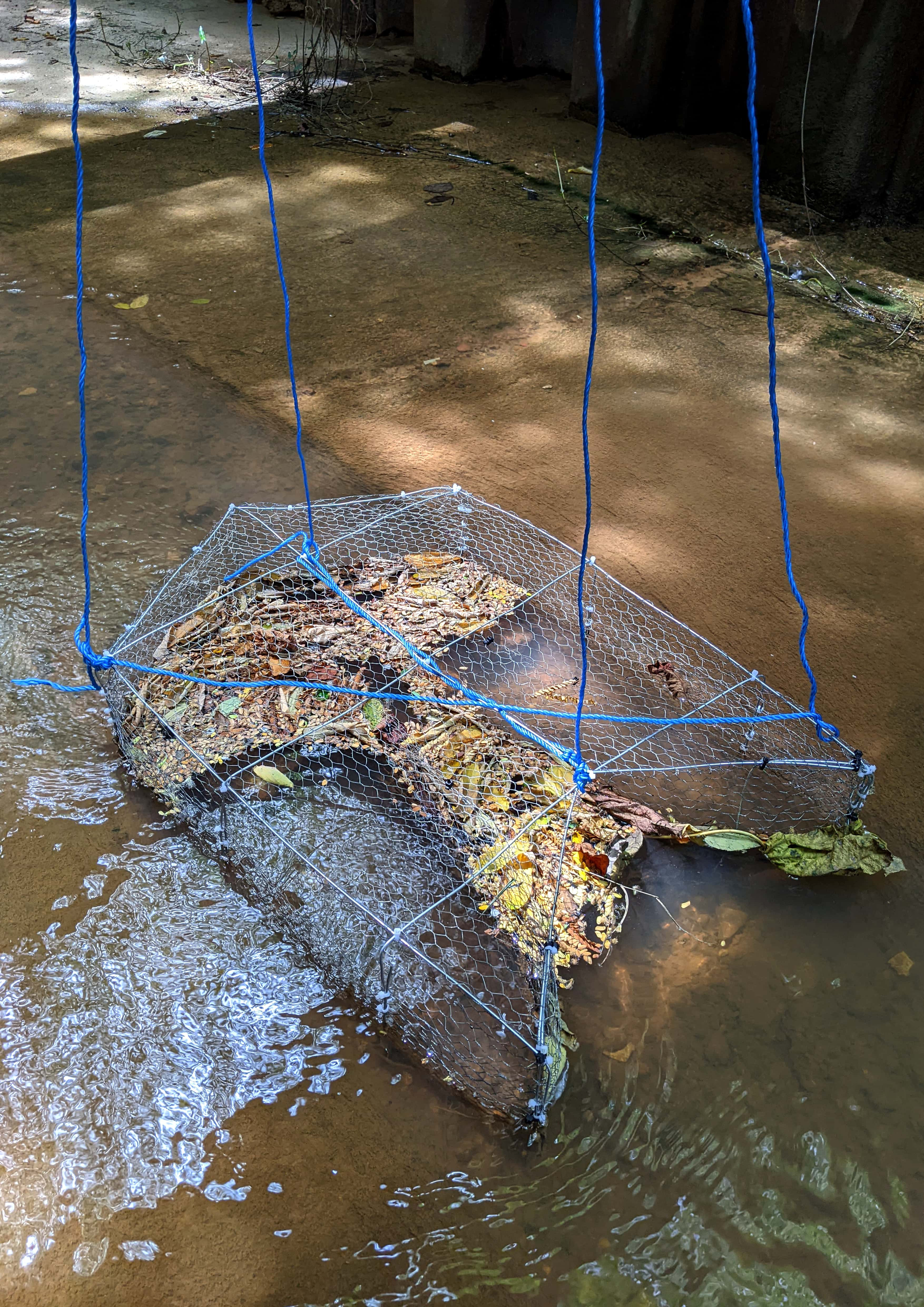
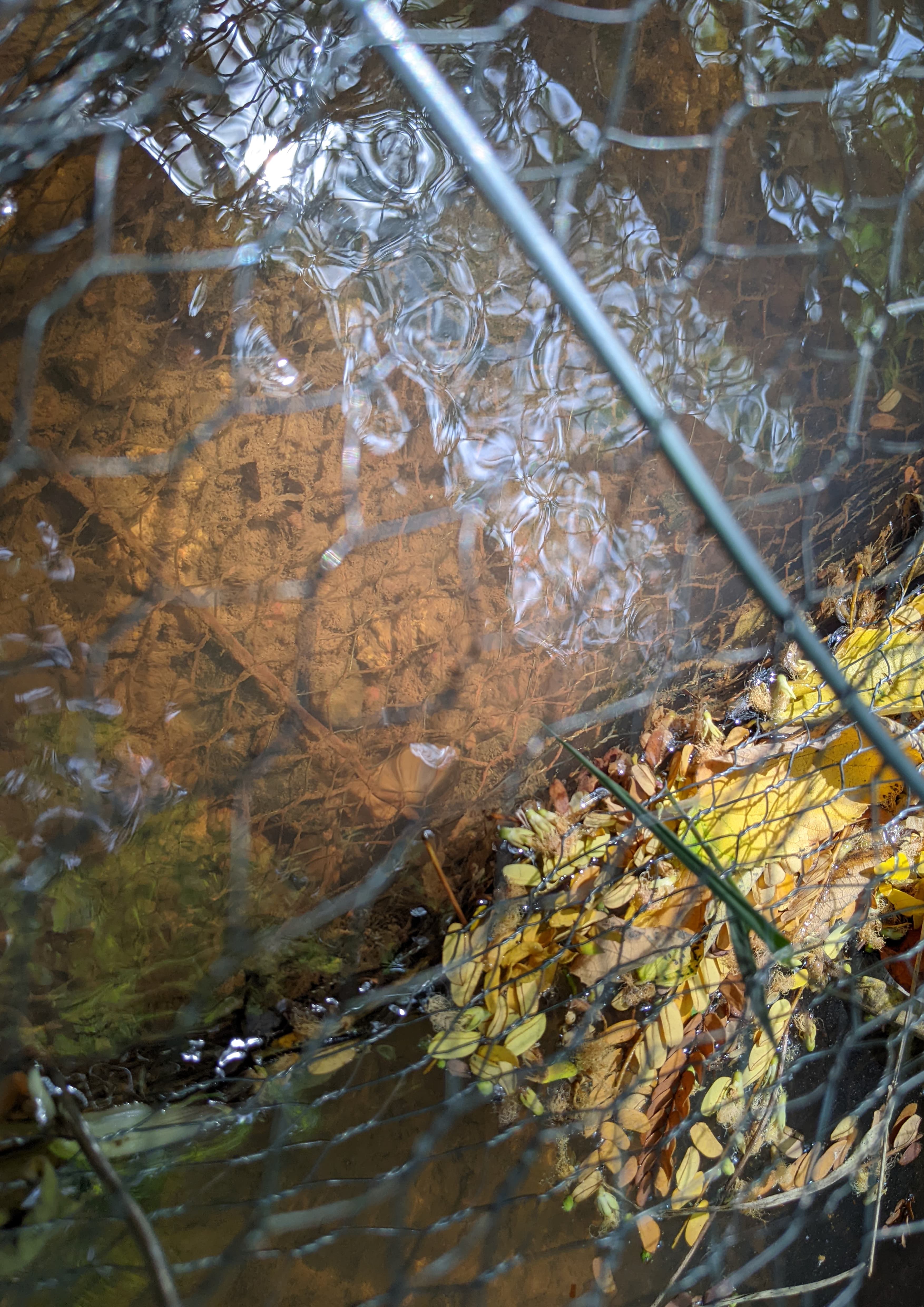
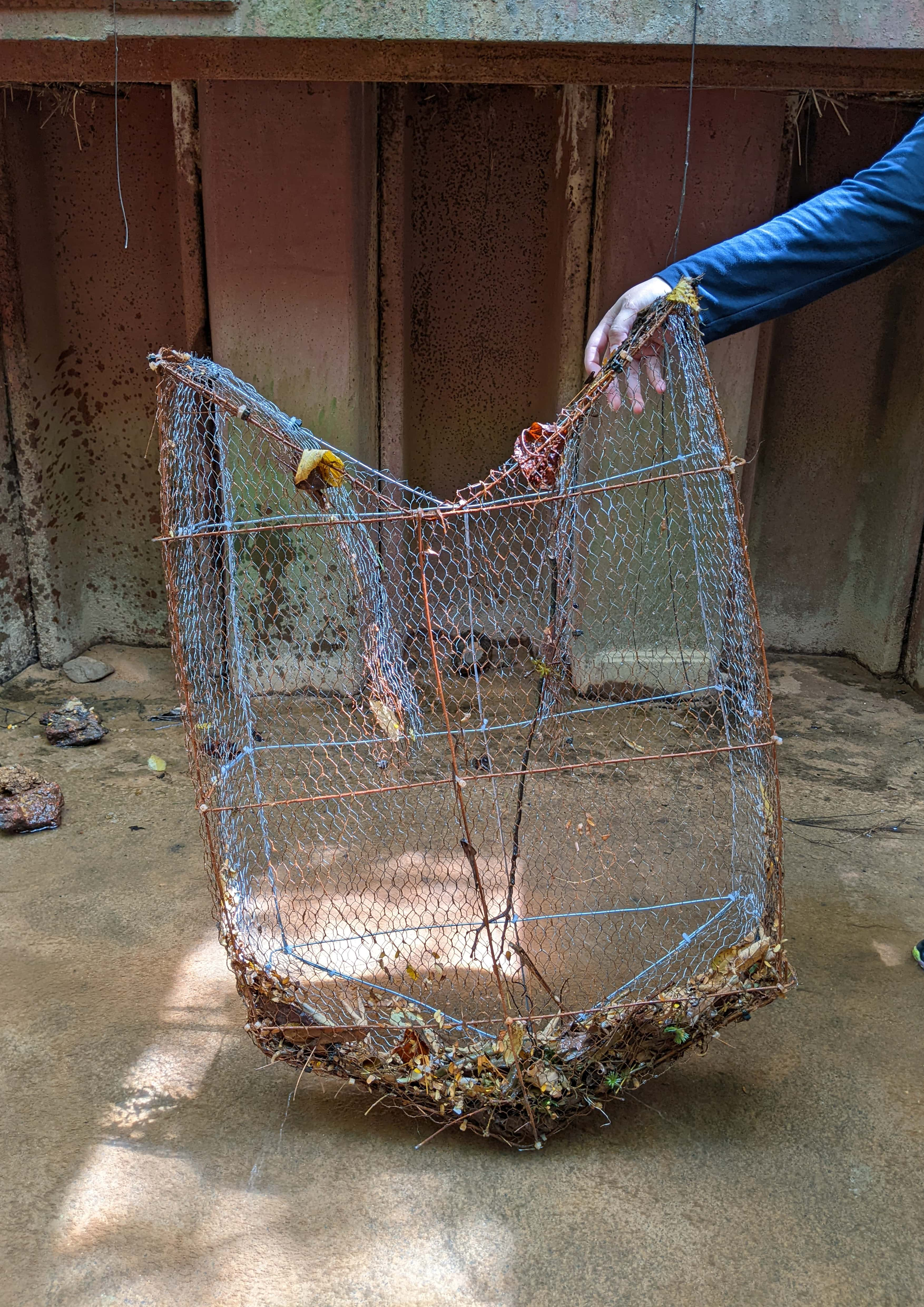
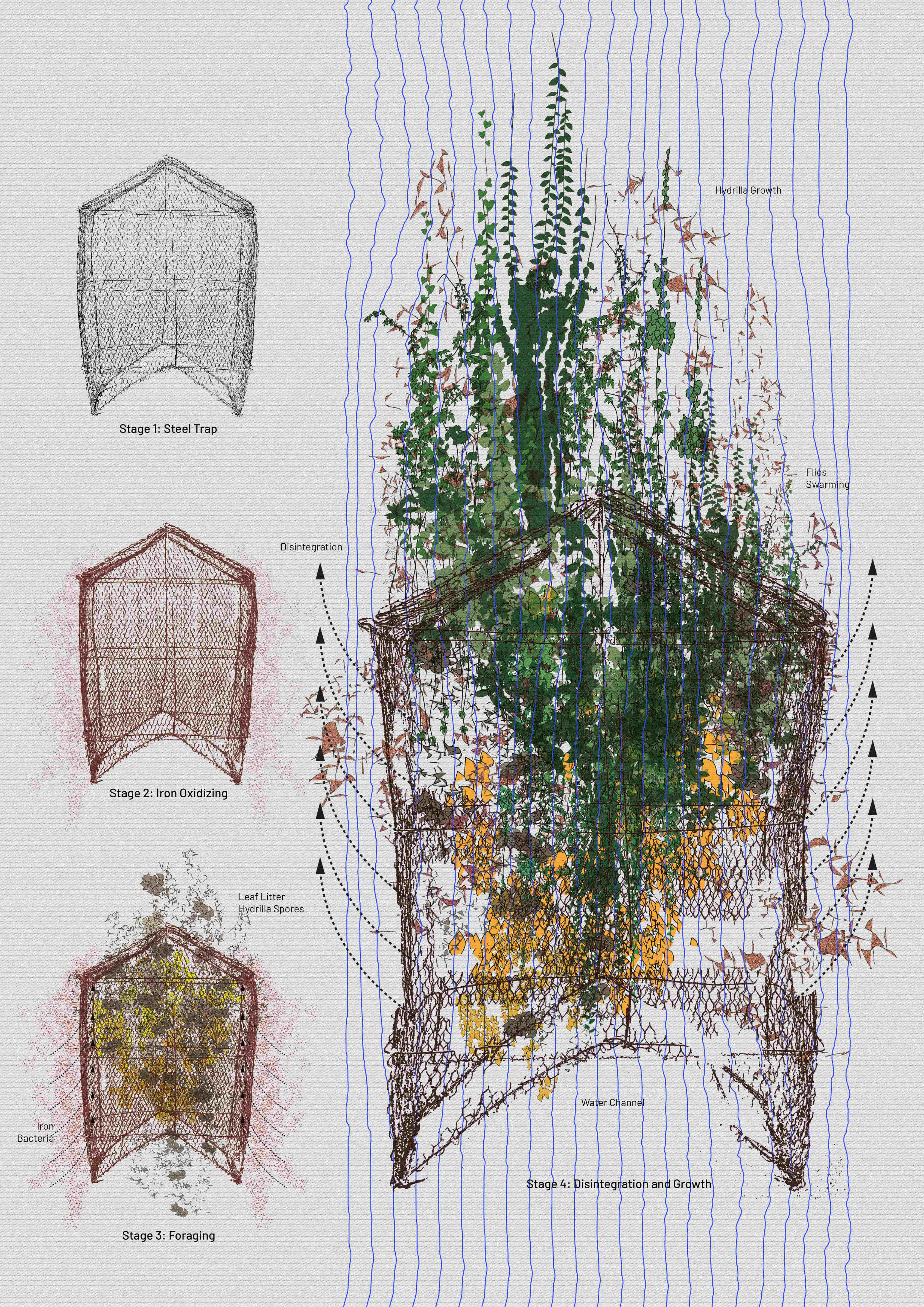












The Inner Coast
新加坡 / singapore
里夫奇·阿什拉夫·本·羅薩利 / Rifqi Ashraf Bin ROSALI
| 新加坡的海岸變得不再像以前那麼容易辨認。由於國家的發展重點,人們目前對海岸的看法產生了變化。因此,海岸線面臨過度,被建造、修整和私有化。海岸周圍不再有人居住,島城的海岸線已成為禁區。此設計重新審視了新加坡的內陸陸地邊緣——內海岸的關係,並由沿著金文泰森林的一條隱藏的運河為發想。 內海岸是通過我的基地穿過森林而發現的,我沿著季風排水溝中的水流,從城市源頭到與野生地形融合的地方,然後流向大海。這個內海岸被表達為通過步行、感知、收集、記錄和在水中安裝實驗性碎屑陷阱的行為獲得的具體知識。該設計重新解釋了覓食者與景觀的密切關係,開發了感知該地點不斷變化的地形的工具,通過社會生物學和氣象時間來顯示。 兩組干預措施,百合傳播器和季風燈塔,輕輕地在運河內。它們放大了排水和侵襲季風風暴的災害,從水中覓食城市碎屑。這些儀器使維護、天氣和生態的有形時間循環。它們更新了我們與內海岸的身體接觸和生態敏感性。 |
More Projects of this Session
展區其他作品
| Singapore’s coasts are no longer recognizable as they were. There is a change in the way people currently perceive the coast due to the city state’s developmental emphasis. Thus, coastlines are built up, manicured and privatized. The sea no longer sustains inhabitation, and the island-city’s coastlines are out-of-bound territories. This thesis relooks at Singapore’s interiorised land-water edges—the inner coast—found along a hidden canal in the Clementi Forest. The Inner Coast is informed by my own site walks through the forest, as I followed the flow of water in the monsoonal drains, from its urban source to where merges within the wild topography, on its way out to the sea. This inner coast is expressed as embodied knowledge gained through acts of walking, sensing, collecting, documenting, and installing experimental detrital traps in the water. Reinterpreting the intimate relations that foragers have with the landscape, the thesis develops tools to sense the site’s shifting topographies, highlighted through its socio-biological, and meteorological temporalities. Two sets of interventions, the Lily Propagator, and Monsoon Beacon, sit lightly within the canal. They amplify the silent movement of drain-water and encroaching monsoonal storms, foraging urban detritus from the water. These instruments make tangible temporal cycles of maintenance, weather, and ecology. They renew our bodily engagements and ecological sensibilities with an inner coast. |
|
| 作品說明Description (1000word) | |
| Singapore’s Coasts are no longer recognizable as they were There is a change in the way people currently perceive the coast due to the Singapore states’ economic and developmental regime. The coastlines are built up, manicured and privatized. The sea no longer sustains inhabitation, and the island-city’s coastlines are out-of-bound territories. Thus this thesis aims to relook at Singapore’s interiorised land-water edges – the inner coast – found along a hidden canal in the Clementi Forest. The thesis is informed by my site walks into the Clementi Forest, where I follow the flow of water in the monsoonal drains, from its urban source to where it dissipates and merges within the wild and wooded topography, on its way out to the sea. This inner coast is portrayed through my embodied experiences of walking, touching, feeling, sensing, collecting, documenting. Taking reference from Mathur and Da Cunha’s photosections from their book SOAK: Mumbai in an Estuary, I made this/these photo section to show the Clementi Forest landscape as I walked the site, producing a view of close-up details of the landscape topography. The maps are divided into terrain, perceived water cleanliness, vistas, notations and landmarks. It sets the stage introducing one to the forested canal, with the negotiation of lines between human routes and canal lines. Two axonometric sections illustrate in greater detail the different socio-biological occurrences I encountered on site. At each repeated visit to the site, I saw the landscape through a different lens, trying to piece one occurrence to the other. What I discovered was a webbed network of ecologies each with its own importance. Some of these are organic occurrences that were analysed in my visits that are directly affected by human interventions. For example, debris running off from the expressway and nearby construction caused an accumulation of silt which in turn produced a propagation of lilies at the mouth of the canal. Being in the canal, I was also constantly exposing myself to danger due to the potential flash floods that might occur during sudden downpour. I was constantly worried that I might not get out of the canal in time as it was difficult to navigate in the soft clayey surface of the riverbed and the slippery steep gradients of the canal. The water could increase up to chest level, observed through the water marks on the canal walls, with fast flowing waters causing the smooth surfaces on the walls that I had observed. I was curious to know what flows out together with the water from the urban interior of the island, to the sea. Inspired by the Orang Laut, and the intimate relations that they have with the landscape as sea foragers, I developed my own Bubu Trap or Fish Trap that was customized and redeployed to now collect trash in the urban waterways, as opposed to its original function to trap fish for food. The process was documented in a form of a film, which highlights these socio-biological occurrences. Plastics cling onto the spiky nature of the steel wires, while fishes swim amongst the leaf litter. A silhouette of green and yellow engulfed the trap, with fruit flies flying around it. Rust started to form only on the face in contact with water, leaving the other half shiny as before. The bubu trap shows leaf, thrash, and growing hydrillas — articulating the clutter of trash in its constituent pieces, it provides a narrative to each artefact found as part of the clutter – finding a way to explore each piece of trash in how it serves the larger drainage eco-system. The Lily Propagator sits lightly within the canal. They amplify the silent movement of drain-waters and encroaching monsoonal storms, foraging urban detritus from the water through the natural filters of the lily roots. In an effort to maintain the cleanliness of the canal environmental NGO’s are involved in maintaining the Lily Propagator. The change in colours (from colourful to muddy brown) reveals the inorganic materials caught. Through growth and decay, it reveals what flows out to sea. Through the maintenance of the canals, the users are involved in making the canal beautiful. What was percieved to be ugly before, is seen as part of the landscape manifested into this spectacle. The monsoon beacon borrows the movement of the dragonfly to act as a visual and auditory indicator of an impending flash flood caused by frequent rains. The flux of tidal heights affect the slackness and tautness of the cable system that flaps the dragonflies’ wings. They act as a shade from the sun or heavy downpour. Flood lights shine onto the canal in the event of high tide, acting as a beacon for the user to pull themselves out through the multiple supporting cables and textured platforms to get the user into safety as fast as possible. These assemblage of dragonflies aims to ingrain the importance of dragonflies to the eco-system. In conclusion, these instruments make tangible temporal cycles of maintenance, weather, and ecology. The thesis strives to express ways of seeing, to express what we see or do not see and what we value or do not value. It highlights what is so particular and fragile about a landscape, in a way that resonates with architecture while protecting an at-risk environment. It hopes to renew our bodily engagements and ecological sensibilities with this inner coast. |
|